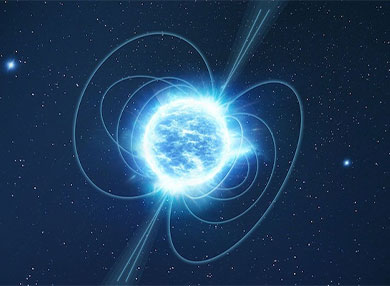Astronomer helps solve Deep Space Mystery
Dr Joanne Dawson has played an important role in a major discovery - the first detection of X-ray emission from a mysterious type of radio object.

Balaclava Rd, North Ryde, Macquarie University
NSW 2109 Australia
Macquarie Astronomer helps pinpoint mysterious cosmic object
Associate Professor Jo Dawson, from the School of Mathematical and Physical Sciences, has played a crucial role in pinpointing the location of a mysterious object in deep space, sending out an extraordinary radio and X-ray signal unlike any previously observed.
Associate Professor Dawson – a radio astrophysicist and associate professor at Macquarie University and research scientist at CSIRO - helped to calculate the distance between Earth and the mysterious object known as ASKAP J1832-0911.
The object was discovered in December 2023 when astronomers using Australia’s SKA Pathfinder telescope spotted it as an unusual bright, circularly polarised radio signal during a sky survey, later confirming its 44-minute cycle and unique X-ray emissions.
Associate Professor Dawson was invited to join an international team of 53 researchers from 32 institutions, helping astronomers decipher possible explanations for the discovery. Her research typically explores how gas in our galaxy evolves into molecular clouds, and she leads major projects investigating galactic interstellar matter.
Specialised knowledge
“The team needed someone with knowledge about how to measure the impact of intervening gas along the sight line,” says Associate Professor Dawson.
“Each time this object sends a pulse of radio waves out, some of them get absorbed by clouds of hydrogen hanging between the Earth and us. My job was to measure the velocity of the absorbing gas and combine that with models of how hydrogen clouds are rotating around in the galaxy to pinpoint its location,” she says.
By analysing how hydrogen clouds absorb radio signals and measuring their Doppler shift – how the wavelengths change based on motion – Associate Professor Dawson could determine where the clouds were located in space.
“You can get an idea of where the hydrogen clouds are because of how they’re moving; they’re rotating around in the galaxy,” she said. Her analysis confirmed the object lies at least 4,500 light-years away – about 42 quadrillion kilometres from Earth.
The object belongs to a rare class called Long-Period Radio Transients (LPTs), which emit radio pulses at unusually slow intervals – in this case, approximately every 44 minutes.
These mysterious objects behave completely differently from typical pulsars (a type of neutron star), which spin rapidly and pulse every few seconds. Instead, LPTs take tens of minutes to hours between pulses – thousands of times longer than normal.
Significant find
What makes this discovery particularly significant is that ASKAP J1832-0911 is the first LPT ever detected emitting both radio waves and X-rays in a coordinated pattern. Previous similar objects had only been observed in radio wavelengths, so this new discovery can help astronomers better understand the phenomenon.
The object was detected by the Australian Square Kilometre Array Pathfinder (ASKAP), a world-class radio telescope made up of 36 identical 12-meter dish antennas arranged across the remote Murchison Radio-astronomy Observatory in Western Australia.

These white, dish-shaped telescopes work together as a single instrument, creating a powerful radio observatory capable of rapidly scanning large portions of the sky to detect faint transient radio signals travelling across vast cosmic distances.
“ASKAP is one of the fastest sky-survey instruments in the world, operational since 2019, and helps us map the universe via radio signals,” says Associate Professor Dawson.
“ASKAP is a precursor and test bed for the Square Kilometre Array (SKA) international observatory due for completion by 2028, to be made up of more than 130,000 antennas spread across Australia and South Africa. The SKA will then be the world’s largest and most sensitive radio observatory,” Associate Professor Dawson says.
Extreme physics
This finding, published in Nature under the title Detection of X-ray emission from a bright long-period radio transient, establishes a new class of periodic X-ray transients and offers important insights into extreme physics.
More than 50 co-authors contributed to the research led by Dr Ziteng Wang from Curtin University, representing Australia, the United States, Spain, Italy, the United Kingdom, Israel and China.
The team concluded the object might be either an extremely magnetised white dwarf with a dwarf companion, or a special type of highly magnetised neutron star called a magnetar.
The discovery also demonstrates how different specialisations within astronomy come together to solve cosmic mysteries and better understand the fundamental forces that shape our universe.